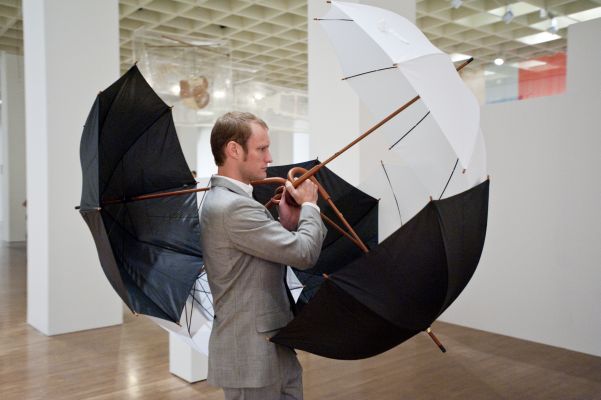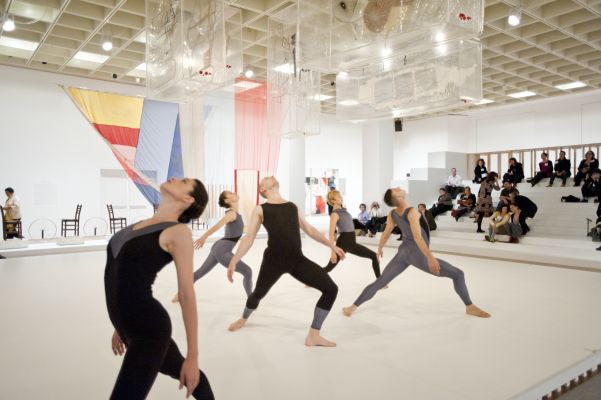
Daniel Squire, curator of the dance program for “Dancing around the Bride”
By Norman Keyes, Jr., Philadelphia Museum of Art Daniel Squire, former member of the Merce Cunningham Dance Company and Curator of the Dance Program for Dancing around the Bride, carries umbrellas during a Cunningham Event on the Main Stage of the exhibition at the Philadelphia Museum of Art, just as Robert Rauschenberg did during the first Cunningham Event in 1964. Photograph by Constance Mensh, Philadelphia Museum of Art.
In 1995, a dance student named Daniel Squire happened to attend a performance by the Merce Cunningham Dance Company at the Riverside Studios in London. The young Squire was completely unprepared for what he saw—dancers rigorously engaged in captivating movements, each one seeming so masterful and at the same time totally uncertain of what every movement’s outcome would be. He was, in his words, “blown away.” Squire moved to New York and enrolled in open classes at the Cunningham Dance Studio. He was swiftly tapped to become an apprentice and then, for eleven years, performed as a dancer in the company.
Squire is currently the dance curator for the Philadelphia Museum of Art’s Dancing around the Bride: Cage, Cunningham, Johns, Rauschenberg, and Duchamp, a major exhibition reconstructing the unfolding moments of creative exchange among five legendary avant-garde artists who famously opened up new directions for 20th century contemporary art. Squire’s part in the show benefits from shared experience and close associations with 14 fellow former Cunningham dancers who are performing in the galleries until the exhibition closes on January 21, 2013. Museum visitors are discovering their dance in spontaneous juxtaposition with its connective tissue in contemporary art: the enigmatic textured paintings of Jasper Johns, brash and brushy Robert Rauschenberg assemblages, the exploratory music of John Cage, all in dialogue or counterpoise with an insouciant father figure, Marcel Duchamp.
It is momentous to animate Cunningham’s masterful choreography amid masterpieces by the artists with whom he was intimately associated, an integrated expression of arts. “As far as I know it’s the first time he’s been surrounded by so many works by these artists,” notes Squire, “and for us, the dancers, we’re facing them in all directions from the stage in the middle of the gallery. As we move, we constantly have a different view of the exhibition, because we’re seeing the work from the stage. It’s very, very inspiring and energizing.”
The exhibition is also an unexpected experience for the Museum’s art-going audience. As many of the dances occur intermittently in the galleries, people encounter them serendipitously. “When I’m sitting on the bleachers and seeing the other dancers arrive on the floor and then go away, I look at what happens in the exhibition,” Squire said. “When the dancers are on, the exhibition will fill up a little more. It’s like watching the exhibition breathe.”
For the dancers apparently, each time a work by Cunningham is performed, the experience in the gallery becomes a new investigation, and over time each is discovering more parallels and deeper relationships among the artists in the exhibition. Squire mentions connections between Cunningham’s dance “Events” and Marcel Duchamp’s readymades. The Events, in which Cunningham collaged pre-existing choreography in response to the readymades, are among the works the dancers will perform frequently between January 10 and January 19, in a sort of Dancing around the Bride finale.
The performances will relate to Cunningham’s Walkaround Time (1968), for which part of Jasper Johns’s original translucent sets designs, painted on plastic, are suspended over the stage, and Travelogue (1977), also benefitting from its actual set décor, Robert Rauschenberg’s billowy, colorful veils and assembly of chairs, dollies, and bicycle wheels called Tantric Geography, placed immediately next to the stage.
Squire explains that each day “we will roll the dice to decide which ones we’ll do,” just as Cunningham would do, an often misunderstood process using chance, the idea being “to open up possibilities that might not have occurred to me, as opposed to relying solely on chance to determine what the events consist of.”

Former members of the Merce Cunningham Dance Company perform in a Cunningham Event on the Main Stage of Dancing around the Bride at the Philadelphia Museum of Art. Left to right: Emma Desjardins, Melissa Toogood, John Hinrichs, Marcie Munnerlyn, and Brandon Collwes. Dancers appear courtesy Merce Cunningham Trust. Photograph by Constance Mensh, Philadelphia Museum of Art.
Squire has added to the January dance program at the Museum a series of collaborations with guitarist Lee Ranaldo, a founding member of Sonic Youth. Ranaldo was among the artists, along with Led Zeppelin’s John Paul Jones, who wrote music for Nearly Ninety, the last piece Merce Cunningham created before his death in 2009. “We decided I would make a timeline for Lee, and Lee will play on January 4, 5, and 6. On guitar he’ll be doing something very similar to what the dancers are doing, and he’ll be overlapping and intersecting with them.”
Historically, spectators of Cunningham performances have sometimes wondered if there is a hidden story line to discover to fully understand the seemingly open-ended phrasing of the artist’s craft. Squire encourages people to trust their own deep-down intuitive response. “Very often people don’t allow themselves to see it for what it is. They should know in Merce’s work they have the freedom to see it however they wish, and don’t have to look for a narrative or story.”
When the Merce Cunningham Company disbanded in 2011, each of the dancers moved on to new opportunities, never expecting to perform the master’s work again. That is, until Philadelphia Museum of Art curators Carlos Basualdo and Erica Battle, with the blessing of the Merce Cunningham Trust, conceived the idea to reconstruct and reinvigorate some of the most formative and influential moments of 20th century art through Cunningham’s interactions with Cage, Johns, Rauschenberg, and Duchamp. The result is deeply heartfelt, reflects Squire. “These galleries are such a fitting environment, and a lot of us are very touched by that. This really does seem the best possible way it could all come back together, since the company no longer exists, and this could be the last time that a group of Cunningham dancers perform his work.”
Dancing around the Bride: Cage, Cunningham, Johns, Rauschenberg, and Duchamp is generously supported by the John S. and James L. Knight Foundation, and continues through January 21, 2013 at the Philadelphia Museum of Art, Benjamin Franklin Parkway at 26th Street, (215) 763-8100, philamuseum.org.
Recent Content
-
Artsarticle ·
-
Artsarticle ·
-
Artsarticle ·

